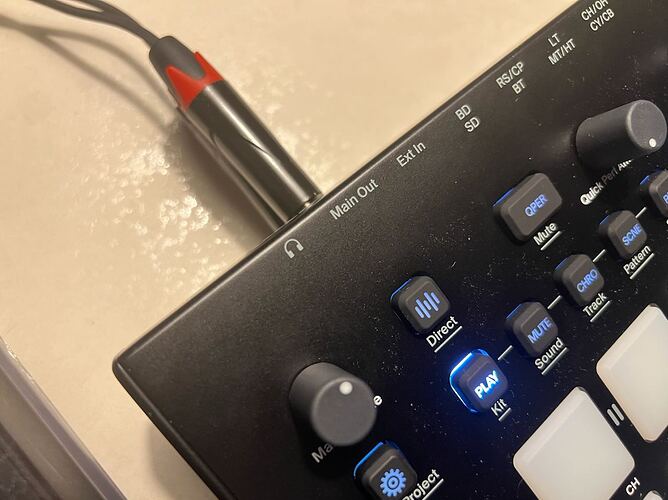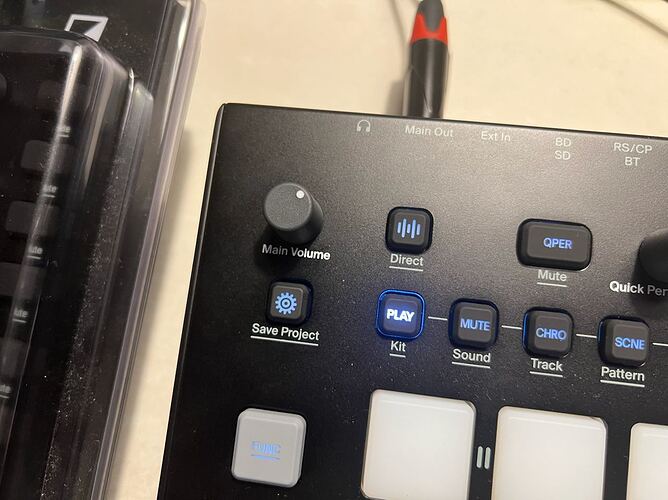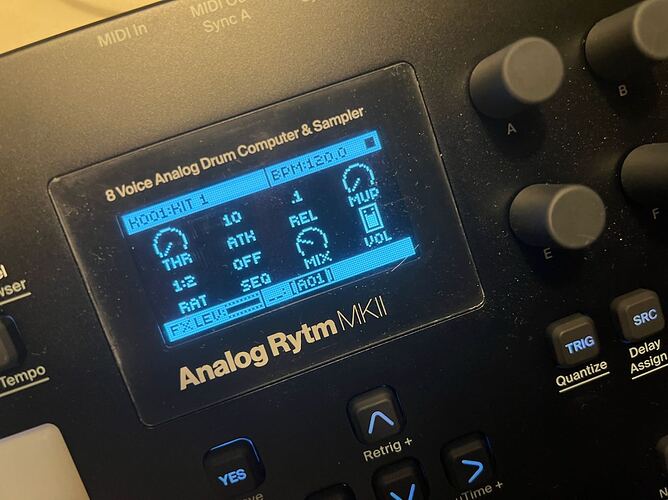How to you gain stage? I’m going by the principle of setting it as high as possible as close to the source as possible. So src and amp all the way up most of the time and then adjust with track level. If I use overdrive I reduce the amp.
yeah that’s pretty much it, src usually full level and then I get the balance between overdrive/amp volume and finally track level if needed, I aim for around -8-6db for the kick in ableton and then I level the other things around it, that way I still maintain some noise but the recording sounds clean enough.
right now I monitor audio from the audio interface which gives me a pre-recording mixer so I can use it to level things while monitoring and still record with as high gain as possible, I actually just started using this way and still in process of finding the best workflow but I tried recording several things both ways and I really like how I get the audio from the interface rather then from OB.
anyway, like standingwave said, analog is the good, the bad and the ugly so the noise is there and part of the AR magic, imo no point fighting it, just try recording the same thing in several ways, bring it to final loudness and see what you like better…
I tried to record audio with RYTM and was disappointed. It makes a lot of noise. This is true. Especially if you record via USB. This kind of recording is no good. Only if you use Denoiser, which will significantly spoil the sound quality. While Analog Four has virtually no noise and no problems with recording.
So far I have solved the problem for myself - recording sounds via Track Out. There is less noise, but these outputs do not support effects and they are mono.
UPD.
I tried everything I could. Here’s what I managed:
 1. USB recording will always contain noise of the same volume. No settings affect it.
1. USB recording will always contain noise of the same volume. No settings affect it. 
 2. Record audio through Main Out and good cables.
2. Record audio through Main Out and good cables.
 3. In the sound settings, turn off the infinity Decay Time, because every time you play a sound, additional infinite noise appears.
3. In the sound settings, turn off the infinity Decay Time, because every time you play a sound, additional infinite noise appears.
 4. Do not turn the main volume to maximum. This creates additional loud noise. Try to use 70-80% of 100%. This is the main thing that solves the problem. Otherwise, try to simply make all sounds louder. For example, use a little Overdrive.
4. Do not turn the main volume to maximum. This creates additional loud noise. Try to use 70-80% of 100%. This is the main thing that solves the problem. Otherwise, try to simply make all sounds louder. For example, use a little Overdrive.
 5. In the compressor, use Threshold to the minimum values. Do not turn the compressor volume to maximum. Look for balance. The compressor can suppress unnecessary noise well.
5. In the compressor, use Threshold to the minimum values. Do not turn the compressor volume to maximum. Look for balance. The compressor can suppress unnecessary noise well.
Hope this helped. But still, this is not an ideal option. You can use Denoiser after recording.
In any case, I’m disappointed with the Rytm, as the Analog Four doesn’t have these issues, and there’s no noise whatsoever when recording via USB.
 This is what technical support told me:
This is what technical support told me:
The Analog Rytm MKI/MKII has a bit more noise in its output signal than a digital device or a VST, and there are several reasons for this:
-
If you set the master volume to max, the output of the Analog Rytm is really hot, so the noise seems more prominent than on many other devices when you turn up the volume.
-
The Analog Rytm has eight separate analog voices that are mixed to a single output (unless you use the separate outputs, of course). It is the same as having eight separate analog synths connected on separate channels in a mixer. Every synth (voice) produces a small amount of noise, but they are all added together.
-
Each of the Analog Rytm’s eight voices goes through several analog components and processes that all add a small amount of noise:
• An analog mixing stage
-
An analog distortion
-
An analog compressor
-
An analog overdrive
-
An analog volume pot
-
An analog output mixer
Here’ss what you can do to keep the noise as low as possible:
-
Turn the mix of the compressor down if you don’t use it in the sound design.
-
Turn down the distortion and overdrive if you don’t use it in the sound design.
-
Good practice for lowering noise is to make sure that each track has the amp set to a decaying value instead of the default INF. While each drum has its separate envelope that closes the analog voice, the VCA is still fully open. To make sure the track VCA is always closing, go to the AMP page of each track and change the decay value to anything lower than INF. (127). You need to re-trigger each track for the decay value change to take effect.
-
Use an external noise gate.
your compressor threshold is set very low, so there is likely a lot of compression going on, which can cause lots of noise. i usually set the threshold at about 3/4 with most tracks at about 100 volume.
regarding usb noise - this can be a thing that is just inherent to audio over usb, depending on your setup. a ground noise isolator can help with that.
however i always use the main outs instead of usb, because i feel they sound much warmer & dirtier (if you want them to).
generally speaking: embrace the noise! resample that and embrace again! 
This is all great details, and seeing it pasted out like this is actually quite useful, especially for those of us who find the Rytm exceptionally clean/dry sounding, can then do the opposite of this to get more noise and grit in the signal path.
I have done all of these already but wasn’t entirely sure if it is actually noisier or not. The main volume and env inf is particularly useful to keep in mind, perhaps reducing the volume of the src/smpl but keeping the env open and loud being a more hissy output for people like myself.
I always wondered if, like the 606/303 Akai sampler inputs, DX100 headphone out over main out for example, volumes set to max, do increase hiss, with 70/80% being optimal for SNR. Particularly with the 606/303, so common is that setting, often they have crackles around that point on the volume pot, which is ironic, given a setting used for good SNR, is now the noisiest part of the pot 
Nice to learn a little on Elektron’s use of their volume, although assuming it’s not boosting like the 606/303 but as they say, only a sum of all the analog paths.
I seem to remember testing individual outputs versus stereo out on a single sound, and didn’t notice a huge difference but others have said it is noticeable. Although i used my 45 year old ears and not any measuring tools.
Useful post and info. Thx 
Yes, I think demanding clean sound from analog is like demanding clean sound from vinyl) We must accept this as a feature of analog, noise that digital equipment cannot make)))



